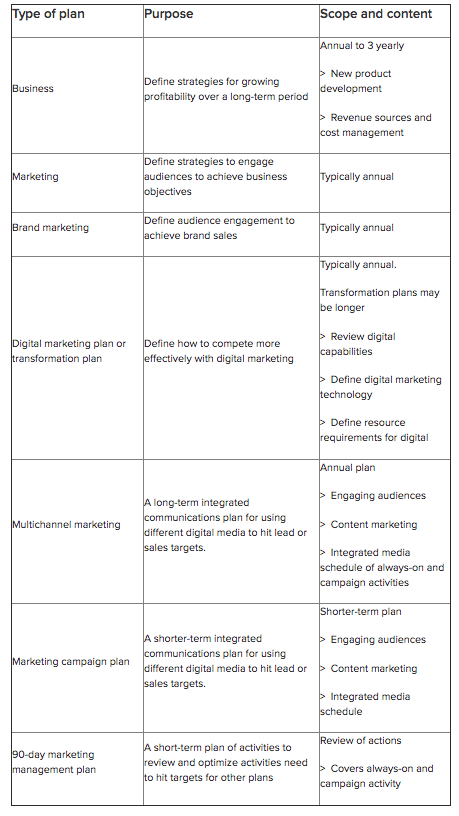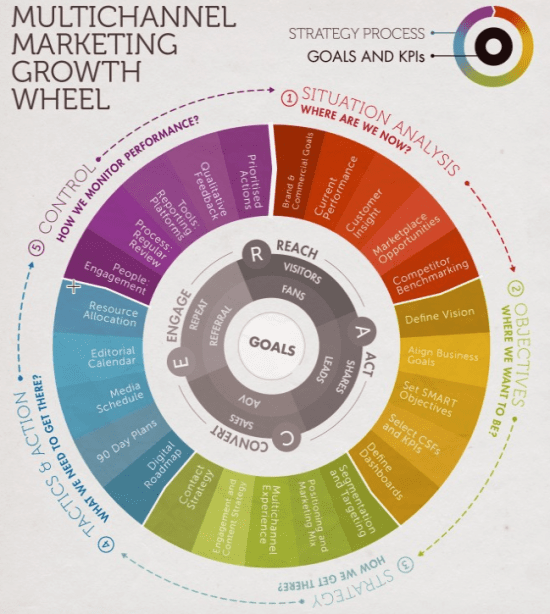What are the essential parts of a marketing plan template?
A marketing plan is a strategic document which specifies your organization’s target markets, marketing objectives, programmes and activities to achieve them, timescales and the resources to be utilized, according to defined budgets.
Our new, free download detailing the different types of marketing plans will help you structure different types of plan and gives recommendations on how to make them effective.
As outlined in the Quick Win – Create a Multi-Channel Marketing Plan, the purpose of a marketing plan is to define strategies to engage audiences in order to achieve business objectives. In smaller businesses, the scope of a marketing plan is typically annual and for the whole business. In larger organizations, its focus will change, depending on the type of organization. A separate marketing plan might be:
- Geographically based
- Product based
- Business unit based
- Focused on segmentation
A marketing plan in a large organization may integrate a number of plans, specific to individual parts of the business. It is practical planning that takes place at divisional, business unit or individual company level.
The purpose of a marketing plan is to ensure that marketing activities are relevant and timely to achieve an organization’s objectives. It’s a plan defining a sustainable competitive position and defining the resources necessary to achieve it.
Here’s another way of understanding the context of this plan, to put it into context with other types of plan as shown in this table:
When to use a marketing plan?
The process of marketing planning within an organization will differ, depending on whether a strategic marketing plan or an operational marketing plan is utilized. Here are the differences between the two:
- A strategic marketing plan outlines the overall strategy within a market, connecting customers, competitors and what the organization is capable of achieving. It is typically created at divisional or company level.
- An operational marketing plan outlines the marketing mix strategy that will be used to gain an advantage in a market. It typically focuses on products; market segments and how marketing communications and campaigns achieve targets defined in the strategic marketing plan. It usually has separate sections covering tactics for customer acquisition and retention which will sometimes be covered in separate plans in larger organizations.
In an organization’s planning process, marketing links:
- Customers’ needs and wants
- Competitor value proposition and actions
- Strategic direction
- Organizational objectives
What should be included? / How should it be structured?
A marketing plan should include:
- The current position, priorities, and direction of your organization
- Its position in relation to external environmental factors
- A critical analysis of your organization’s strengths, weaknesses, opportunities, and threats
- Clearly defined objectives and a way to benchmark their success
- The means by which to achieve those objectives
- Relevant and timely actions and responsibilities by function, product or service, and market segment
- The finances and resources required and forecasted revenues
- Regular measurement of progress and outcomes against benchmarks
A solid marketing plan has:
- Clear, realistic goals which you can be confident of hitting
- The best strategy to achieve these goals against your competition
- Sufficient details of the tactics and actions needed to translate the strategy into action
- A method to check you are on track with your plans
Applying SOSTAC® to marketing campaign planning
To make sure your marketing plan has all the essential features, I recommend the SOSTAC® structure developed by PR Smith—Dave Chaffey’s co-author of the printed book Digital Marketing Excellence. SOSTAC® is a great framework for structuring business, marketing or digital marketing plans since it’s relatively simple and logical, so it’s easy to remember and to explain to colleagues or agencies. SOSTAC® is a strategic planning process framework that gives you a clear structure to work through to create and manage your plan.
Which type of business is it most suited for?
Marketing planning will assist in the day-to-day running of any size, type or age of business. The targets and milestones set will help organizations, from small start-ups to large corporates, to effectively:
- Allocate resources and budget
- Motivate teams
- Manage the performance of staff members and marketing efforts
Larger organizations with clearly defined management structures and a wealth of resources will make use of marketing principles very differently from smaller organizations.
Smaller organizations typically have:
- Small market shares
- Owners involved in all aspects of strategic and operational management
- Independence
- A high degree of uncertainty
- Difficulty innovating owing to limited resources
Such differences between large and smaller organizations tend to be reflected in the development of marketing plans.
When establishing a small start-up, marketing planning is an essential element. A small number of these businesses launch and grow, but for those that are successful, a strategic marketing approach will ensure continued development.
Although the techniques for marketing planning may vary between different sizes and types of organization, the outcome is always the same: to implement the objectives, strategies and activities in order to gain an advantage.
How does a marketing plan relate to other plans?
A marketing plan should not be formulated or used in isolation; it should be informed by the corporate objectives identified in your organization’s business plan.
Integrated with a marketing plan may also be a digital marketing plan, multi-channel marketing plan and a campaign plan, for example. The marketing plan informs these plans and vice-versa.
An effective marketing plan will ensure the integration of activities, the scheduling of requirements, distinguishing responsibilities and the provision of benchmarks for measuring success. Different organizations will utilize differing plans, covering different areas and timeframes. What is crucial in a business is that the plans being utilized, the timeframes allocated and how they integrate with each other are collectively established.
To find out about more about how different types of marketing plans and how to structure them, download our free Understanding different marketing plans guide, which includes campaign planning, digital transformation plans and multichannel plans.
source http://www.smartinsights.com/marketing-planning/create-a-marketing-plan/structure-effective-marketing-plan/


No comments:
Post a Comment